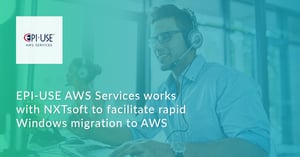According to Stack Overflow’s 2023 Developer Survey, SQL is the most-used database among professional developers. And yet, many companies still manage their own on-premises databases or dedicate full teams to managing these databases in the cloud. In addition to the management time and expense, essential application architecture for SQL and .NET applications are chained to licensing agreements that require constant upgrading.
Modern open source and cloud-native workloads provide the freedom to deliver application changes and enhancements faster and more efficiently, instead of being tied to full-scale platform upgrades, patches, or backups. Modernization has positive implications for the agility of your team, the efficiency of your application, and your bottom line. Consider these four reasons you should move to cloud-native AWS (Amazon environments).
1. Increased Agility and Reduced Licenses
Today’s software landscape requires agility to adapt to rapidly changing markets, supply chains, and economic factors. Development infrastructure and platforms similarly need to provide the agility to keep pace. Modernizing applications into microservices allows developers to deploy more frequently because they can work independently on modules that work together. Serverless architectures offload the server maintenance and upgrades to the infrastructure provider, which saves developer resources for more business-critical tasks, increases overall security, and takes advantage of the provider’s ability to scale.
When companies move their .NET applications to Linux on AWS, they can take advantage of the power and savings of AWS Graviton which has built-in security and speeds compute processes over competitor CPUs. Further modernizing .NET applications to microservices adds the additional scaling benefits of containerized computing through Amazon Elastic Container Services (ECS) or Amazon Elastic Kubernetes Service (EKS). Additionally, by modernizing to serverless architectures like AWS Lambda, you can break free of the high costs and constant upgrades associated with licensing.
AWS also brings agility to SQL Servers with the flexibility to choose platforms. There’s no better time to modernize Microsoft SQL Server away from on-prem or other cloud providers or take the next step after lift-and-shifting onto AWS EC2. As Microsoft moves away from legacy versions of SQL Server, many organizations who failed to update along the way are now left stranded with outdated and unsupported licenses.
2. Develop Efficiency with Cutting-Edge Technology
Organizations that choose to modernize .NET applications from monolith to a microservices architecture find that they are more efficient to maintain and upgrade as work—and bugs—can be localized and containerized. And modernized solutions on AWS have a range of options for platforms, meaning developers can choose the right-fit platform for the individual service, rather than be locked-in to only what the provider offers. EPI-USE client, Chandler Concrete urgently needed to migrate away from Classic AWS. EPI-USE was able to quickly divide their on-prem .NET application, transform those functions into Lambda functions, and modernize to a managed AWS cloud instance.
The efficiency of AWS extends all the way to the hardware. Testing performed by Principled Technologies in 2021 reported 2x higher performance than Azure VM for a SQL server workload on AWS Relational Database Servers (RDS). The study compared Amazon EC2 r5b.8xlarge and Azure E64_32s_v4 VM, both running on Cascade Lake Intel Xeon processors. Principled Technologies stated in the report that to bring the Azure compute power to the same level, they incurred extra cost over the Amazon option, but that also included more memory than EC2 for the price. This increased performance trickles down to a lower overall carbon footprint while increasing application and end-user performance.

Image: Principled Technologies
3. Reduce Total Cost of Ownership through Modern Services on AWS
EPI-USE modernizes SQL Server applications on AWS, beginning with a complete analysis of current server and platform architecture with a Windows Holistic Application and Licensing Evaluation (W.H.A.L.E) migration assessment. The W.H.A.L.E. specialists map existing Microsoft and SQL Server environments and licenses, identify risks, and build a migration roadmap, complete with best-practices based recommended actions.
With the W.H.A.L.E assessment, EPI-USE works with your team to spot the current inefficiencies in your application architecture. By moving from on-premises servers, other cloud providers, or even AWS EC2 to full AWS services, you decrease the cost of servers, licenses, and service contracts. Then, our experts can advise your team on open source or serverless opportunities to further reduce licensing costs or the best way to deconstruct your application into efficient and affordable microservices.
4. Improve ROI with Technology and Resources
Agility, efficiency, and reduced total cost of ownership all add up to improved return on investment with cloud-native computing. Services like AWS Lambda and AWS Fargate automatically conserve resources according to need, meaning you pay per workload instead rather than by instance.
Consolidating services under AWS means your Amazon Native Services experts are on-hand to provide you with the plans and execution to make the most of your move—and beyond. This frees your internal team to do the work they love; innovating and improving your applications for end-users. The internal stakeholders who previously spent their time responding to database administrative troubles and trying to squeeze savings out of licenses can now focus on improving application performance and solving the problems that make money for the company.
Modernize Successfully with AWS
Managed cloud-native and serverless environments have been popular for a long time, but today’s economies of scale and speed mean that organizations must modernize before they get left behind. AWS partners get the advantage of expert architectures, the speed of purpose-built hardware, and the cost savings of a single cloud provider.
Ready to find out how EPI-USE can help you modernize your SQL and .NET applications with AWS? Click below for a free Microsoft Modernization Viability Assessment.



